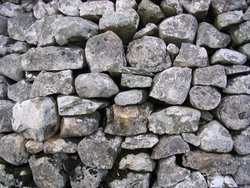Dry-stone wall
|
|

A dry-stone wall, dry-stone dyke or dry-stone hedge is a wall that is constructed from stones without any mortar to bind them together. The wall is held up by a special construction method and by its own weight, and the stones must be carefully selected by shape to ensure that they have a large contact surface area with their neighbours and so do not slip. Such walls are used both in building construction and as field boundaries.
| Contents |
Location and terminology
Terminology varies regionally. When used as field boundaries, dry-stone structures are often known as dykes, particularly in Scotland, and to some extent in the North of England. Since dry-stone field boundaries are commonest in those regions, this article will mostly follow that usage. The term "wall" will be used here for a dry-stone structure that is part of a building, or part of a dyke. However either term may be used for a field boundary without risk of confusion. The term "dry-stone hedge" is less common.
Dry-stone dykes are characteristic of Scotland, rural parts of Ireland, and of the upland countryside of England, particularly in the north and the southwest. Such constructions are common where large stones are plentiful (for example, in The Burren) or conditions are too harsh for hedges capable of retaining livestock to be grown as reliable field boundaries. Many thousands of miles of such walls exist, most of them centuries old.
Construction
There are several methods of constructing dykes, depending on the quantity and type of stones available. Most dykes are constructed from stones and boulders cleared from the fields during preparation for agriculture. In areas where stones are plentiful double wall dykes are preferred but where stones are scarcer single wall dykes may be made. If the area contains boulders, boulder dykes will often be constructed. Boulder dykes are a type of single wall dyke in which the bottom row consists of boulders, upon which and around which smaller stones are placed.
A double wall dyke may be constructed by placing two rows of stones along the boundary to be walled. The rows are basically large flattish stones. Smaller stones may be used as chocks in areas where the natural stone shape is more rounded. The walls are built up to the desired height layer by layer, and at intervals, large tie-stones are placed which span both walls. These have the effect of bonding what would otherwise be two thin walls leaning against each other and greatly increase the strength of the dyke. The final layer on the top of the dyke also consists of large stones, called cap stones. Like the tie stones, the cap stones span the entire width of the dyke and prevent it breaking apart.
Single wall dykes work best with flatter stones. The largest stones should be placed at the bottom of the wall and the whole wall should taper towards the top.
Whichever method is used to build a dyke, a good deal of skill is required. The choice of the correct stone for every position in the dyke makes an enormous difference to the lifetime of the finished product and a skilled dyker will take time over the selection.
While the dry-stone technique is generally used for field enclosures, it was also used for buildings. The traditional turf-roofed Highland Black house was constructed using the double wall dry stone method. When buildings are constructed using this method, the middle of the wall is generally filled with earth or sand in order to eliminate draughts. During the Iron Age and perhaps earlier, the technique was also used to build fortifications such as the walls of the Maiden Castle, Reeth and the rampart of the Long Scar Dyke.
As with many older crafts, skilled dykers are in short supply. With the advent of modern wire fencing, fields can be fenced with much less time and expense using wire than using stone dykes. However the initial expense of building dykes is offset by their sturdiness and consequent long, low-maintenance lifetimes. As a result dykers remain in demand, as do the dykes themselves.
Famous dry stone walls
Mourne Wall - 22 mile long wall in the Mourne Mountains location in County Down, Northern Ireland.
External links
- Dry Stone Walling Association of Great Britain (http://www.dswa.org.uk/)
- British Trust for Conservation Volunteers skills page on dyking (http://www.btcv.org/skills/walls/drystone.html)
- BTCV dry stone walling book (http://handbooks.btcv.org.uk/handbooks/index/book/61)
